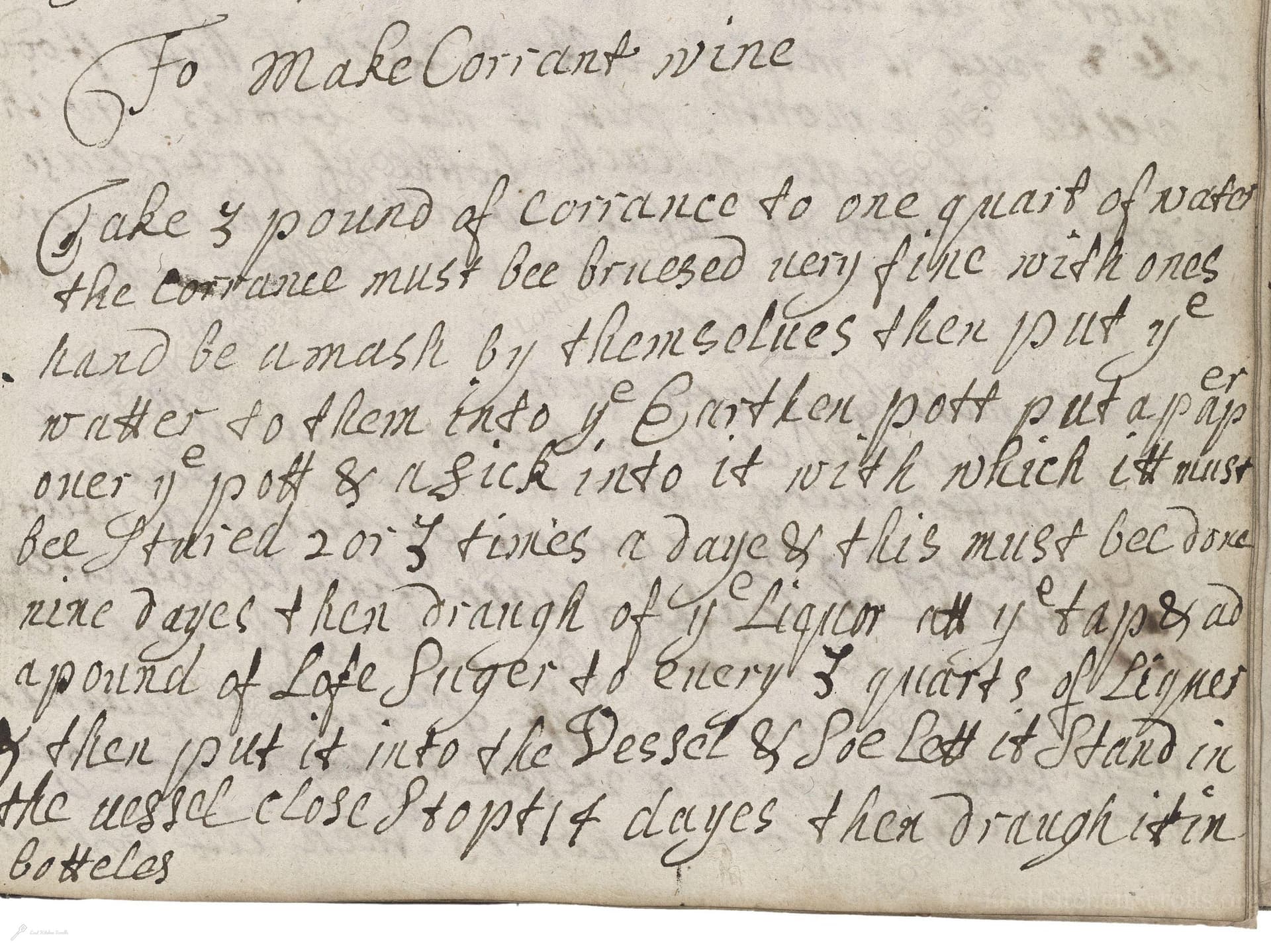To Make Corrant Wine
From the treasured pages of Medicinal and cookery recipes by John King
Written by John King

To Make Corrant Wine
"Take 3 pound of Corrance to one quart of water the Corrance must bee brused very fine with ones hand be a mash by themselves then put ye water to them into ye Earthen pott put a paper over ye pott & a sick into it with which it must bee stired 2 or 3 times a day & this must bee done nine dayes & then draugh of ye Liquor att ye taps & ad a pound of Lofe Suger to every 3 quarts of Liquor & then put it into the Desset & Soe Lett it stand in the vessel close stopt 14 dayes then draugh it in bottels"
Note on the Original Text
The recipe is characteristically brief and trusting of the reader’s knowledge, omitting exact measurements and detailed steps in favor of broad guidance—the hallmark of early modern English cookery. Spelling follows 17th-century norms: 'Corrance' for currants, 'bee' for be, 'ye' for the, 'mashed by themselves' for mashed on their own. The procedural language ('draugh of ye Liquor att ye taps') references the practice of tapping liquids from a vessel. Modern readers must translate these instructions and adapt quantities, but the core processes remain timeless: extraction, fermentation, and bottling. This culinary shorthand, flavored with period spelling, is both practical and poetic—a snapshot of the domestic arts from another age.

Title
Medicinal and cookery recipes by John King (1675)
You can also click the book image above to peruse the original tome
Writer
John King
Era
1675
Publisher
Unknown
Background
A delightful journey into the kitchens of the 17th and early 18th centuries, this collection, attributed to John King, brims with time-honored recipes, culinary wisdom, and flavors that once graced historic tables.
Kindly made available by
Folger Shakespeare Library
This recipe is drawn from the English manuscript tradition, penned somewhere between 1625 and 1725, a period when home winemaking was popular among the gentry and well-to-do households. 'Corrance' refers to currants, a tart berry native to Europe and often used for preserves and cordials. At a time when imported wines were expensive, such recipes allowed families to create their own festive beverages from garden produce. The manuscript belongs to the collection of John King, situating the recipe in a world where culinary and medicinal arts were closely intertwined. Handwritten manuscript recipes from this era are prized windows into daily life, revealing how households preserved harvest abundance and enjoyed the delights of fermented drinks long before modern oenology.

Back then, currants would be mashed by hand or with a wooden pestle, and the fermenting liquid mixed with a clean stick or wooden spoon. Large earthenware crocks or stoneware pots served as fermentation vessels. Simple coverings like parchment or cloth protected the fermenting wine, while strings or cords kept things secure. Wine was later drawn off through a tab (a spout or tap at the bottom of some pots), and strained with linen cloths or sieves, then transferred into glass bottles and sealed with cork or parchment.
Prep Time
30 mins
Cook Time
0 mins
Servings
6
We've done our best to adapt this historical recipe for modern kitchens, but some details may still need refinement. We warmly welcome feedback from fellow cooks and culinary historians — your insights support the entire community!
Ingredients
- 3 lb fresh black or red currants
- 1 qt water
- 1 lb white granulated sugar (substitute for 'loaf sugar') for every 3 quarts liquid
Instructions
- To make currant wine in the modern kitchen, begin by taking 3 pounds of fresh currants for every 1 quart of water.
- Thoroughly crush the currants by hand or with a potato masher, blending them to a pulp.
- Place the mashed fruit into a ceramic or glass container, add the measured water, and cover the vessel loosely with parchment paper (or a clean kitchen towel) secured with string or a rubber band.
- Stir this mixture twice or three times daily with a clean wooden spoon for nine days to encourage natural fermentation.
- After nine days, strain off the liquid—the nascent wine—through a fine sieve or cheesecloth and measure it.
- For every 3 quarts of liquid, stir in 1 pound of white granulated sugar.
- Transfer the sweetened juice to a clean fermentation vessel fitted with an airlock or sealed tightly.
- Allow it to rest and ferment for another 14 days.
- Finally, carefully decant or siphon into bottles and seal, letting the wine age to develop its flavor.
Estimated Calories
120 per serving
Cooking Estimates
Preparing the currants and mixing them with water takes about 30 minutes. There's no cooking involved, but the wine needs to ferment for over three weeks before it's ready to bottle. Each serving has about 120 calories, and this recipe makes around 6 servings.
As noted above, we have made our best effort to translate and adapt this historical recipe for modern kitchens, taking into account ingredients nowadays, cooking techniques, measurements, and so on. However, historical recipes often contain assumptions that require interpretation.
We'd love for anyone to help improve these adaptations. Community contributions are highly welcome. If you have suggestions, corrections, or cooking tips based on your experience with this recipe, please share them below.
Join the Discussion
Rate This Recipe
Dietary Preference
Main Ingredients
Culinary Technique

Den Bockfisch In Einer Fleisch Suppen Zu Kochen
This recipe hails from a German manuscript cookbook compiled in 1696, a time whe...

Die Grieß Nudlen Zumachen
This recipe comes from a rather mysterious manuscript cookbook, penned anonymous...

Ein Boudain
This recipe comes from an anonymous German-language manuscript cookbook from 169...

Ein Gesaltzen Citroni
This recipe, dating from 1696, comes from an extensive anonymous German cookbook...
Browse our complete collection of time-honored recipes



